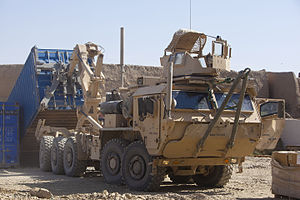Oshkosh Logistic Vehicle System Replacement (LVSR)
| Oshkosh Logistic Vehicle System Replacement (LVSR) | |
|---|---|

U.S. Marine's Oshkosh Logistic Vehicle System Replacement (LVSR)
|
|
| Type | Family of 10x10 tactical trucks with 45,000 pounds (20,000 kg) payload (MKR18 cargo) |
| Place of origin | United States of America |
| Service history | |
| In service | 2009–present (first fielding 2009) |
| Used by | U.S. Marines |
| Production history | |
| Designer | Oshkosh |
| Designed | March 2004 (LVSR Phase I System Development and Demonstration Contract award) |
| Manufacturer | Oshkosh Corporation |
| Produced | 2005-2013 (remains available) |
| Number built | 2022 |
| Variants | MKR18 – cargo (1459) MKR15 – wrecker (160) MKR16 – tractor truck (381) |
| Specifications | |
| Weight | 24,517 kilograms (54,051 lb) unladen, 44,929 kilograms (99,051 lb) laden (A-kit configuration; B-kit adds approx. 2,041 kilograms (4,500 lb)). Towed load 24,040 kilograms (53,000 lb) kg |
| Length | 10.98 metres (432 in) |
| Width | 2.490 metres (98.0 in) |
| Height | 4.11 metres (162 in) (with ISO container) |
| Crew | 2 (third space for optional gunner position) |
|
|
|
| Armor | a-kit/b-kit; U.S. Army Long Term Armor Strategy (LTAS) compliant |
| Engine | Caterpillar (CAT) C-15 15.2-liter, 6-cylinder inline water-cooled diesel developing 600 hp @ 1800 rpm and 2508 Nm torque at 1200 rpm |
| Payload capacity | 20,412 kilograms (45,001 lb) kg |
| Transmission | Allison 4700SP 7-speed automatic and Oshkosh 35000 single-speed transfer case |
| Suspension | Oshkosh TAK-4 independent. Front axles rated at 7,666 kg; rear axles rated at 10,478 kg |
| Fuel capacity | 628 litres |
|
Operational
range |
483 kilometres (300 mi) |
| Speed | 105 kilometres per hour (65 mph) |
|
Steering
system |
Power-assisted, 1st, 2nd, 4th and 5th axles (mechanically controlled 4th and 5th axle contra-steer) |
The Logistic Vehicle System Replacement (LVSR) is a family of vehicles, based on a common 5-axle ten-wheel drive 10x10 chassis, that vary in individual configuration by mission requirements. The LVSR was designed and is manufactured by Oshkosh Defense. LVSR is a purpose-designed military vehicle and there are currently three variants in service, a cargo, a wrecker and a tractor truck.
The first LVSRs were ordered in 2006. The LVSR is the U.S. Marines’ equivalent of the U.S. Army’s Oshkosh Heavy Expanded Mobility Tactical Truck (HEMTT) and Oshkosh Palletized Load System (PLS). The Marines do not use the HEMTT or PLS and the Army does not use the LVSR, but both services use a common trailer (M1076) with all three truck types.
The predecessor of the LVSR, the MK48 Logistics Vehicle System (LVS), had entered service with the US Marine Corps (USMC) from 1985 and in the late 1990s a project to replace the LVS was started.
As a precursor to a formal LVS replacement programme a number of manufacturers co-operated with the USMC to build and evaluate an Advanced Technology Demonstrator (ATD). The ATD was built during 1998 at the Nevada Automotive Test Centre (NATC). LVS Modification Demonstrators (LVS-MDs) were also built, these integrating commercially proven automotive components and technologies.
In April 2001, Logistics Management Institute (LMI) completed their final report for the 'Analysis of Alternatives (AoA) for the USMC Logistics Vehicle System Replacement (LVSR), concluding the best option was to rebuy a vehicle similar to the technology demonstrator. Five alternative options had been considered, these were: Inspect and Replace Only As Necessary (IROAN) for the LVS; rebuild the LVS; re-manufacture the LVS to a higher standard; rebuy a vehicle similar to the technology demonstrator; research and develop an entirely new vehicle. Around this time it was suggested that 2,000-3,000 vehicles might be required, although throughout the program numbers would fluctuate.
...
Wikipedia
